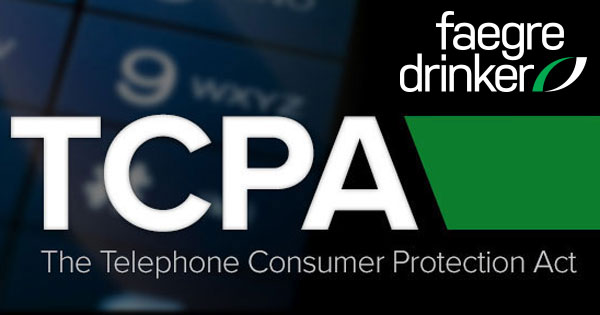In a decision released on April 7, the Second Circuit joined the Ninth Circuit in adopting an expansive interpretation of what qualifies as an Automatic Telephone Dialing System (ATDS), finding that online texting platforms that use human-generated lists and require a human to click “send” on a screen to initiate the texts falls within the statutory definition. Duran v. La Boom Disco, Inc., No. 19-600, 2020 WL 1682773, at *8–9 (2d Cir. Apr. 7, 2020). In an effort to respond to expected critics of their approach, the court explained its view of why “so-called smartphones” and other modern devices do not qualify as an ATDS despite having similar functionality to the online texting platforms at issue (the ability to store a list of numbers and to dial them by simply clicking “send”). Id. at *8 n.39. The decision deepens the divide between circuit courts on what qualifies as an ATDS.
The Duran plaintiff sued the defendant alleging he received hundreds of unsolicited text messages after he texted a code for free admission to a party in response to a Facebook advertisement. The defendant argued that the texts did not violate the TCPA because the online texting programs it used were not ATDSs. Specifically, it argued that although the systems were able to send hundreds of texts simultaneously, they did not have either of the two capacities required to qualify as an ATDS and required too much human intervention to be considered “automatic.” The district court agreed, and granted summary judgment for defendant.
Acknowledging the split among circuit courts on this issue, the Second Circuit reviewed the issue de novo. The court began by noting that “a dialing system qualifies as an ATDS if it has two concurrent capacities. First, it must have the ‘capacity… to store or produce telephone numbers to be called, using a random or sequential number generator[.]’ Second, it must have the ‘capacity. ..to dial such numbers.’” Duran, 2020 WL 1682773, at *3. Recognizing that this statutory language is less than clear and “leaves much to interpretation,” the court considered both prongs in turn.
Regarding the first prong, the court read the statutory language to mean that, in order for a program to qualify as an ATDS, the phone numbers it calls must be either stored in any way or produced using a random- or sequential-number generator. The court acknowledged that other courts had offered contrary interpretations of this language, but felt its interpretation was correct because it did not render any word in the statute mere surplusage, effectuated Congress’s intent, and was consistent with the FCC’s long-standing interpretations of the TCPA. Significantly, as to the latter point, the court found that the FCC’s 2003, 2008, and 2012 Orders interpreting the definition of ATDS remained viable notwithstanding the D.C. Circuit’s decision in ACA International.
Ultimately, the court held that the online texting programs could qualify as ATDSs merely because they stored the numbers, even though the list of numbers was human-generated and manually uploaded to the programs.
As to the second prong, the court acknowledged the significant human action required to operate the texting programs: a human uploaded the text to be sent, determined the time it would be sent, and manually initiated sending. However, the court held that such human intervention was insufficient to make the systems non-automatic, and concluded that the systems had the requisite dialing capacity to be considered an ATDS. The court reasoned that “[w]hen a person clicks ‘send’ in such a program, he may be instructing the system to dial the numbers, but he is not actually dialing the numbers himself. His activity is one step removed.” Id. at *8.
Significantly, in a footnote, the court recognized that some may find its definition of “dial” out of step with modern-day usage:
Critics of our approach may suggest that our definition of “dial” is out of step with common usage. After all, many people now use so-called smartphones to call or text their “contacts,” and they often do so without directly “inputting” any specific numbers—but instead by merely selecting a “contact” from a digital phonebook or by asking Siri or Alexa to accomplish the task. These critics may suggest that, by relying on an antiquated notion of “dialing,” we are unintentionally defining all smartphones as ATDSs, since clicking on a name in a digital phonebook to make a phone call or send a text message looks the same as clicking “send” to initiate a text campaign. No inputting of numbers takes place.
See id. at *8 n.39.
The court then attempted to distinguish smartphone-esque “dialing” from prohibited autodialing, stating that “[c]licking on a name in a digital phonebook to initiate a call or text is a form of speed-dialing or constructive dialing that is the functional equivalent of dialing by inputting numbers.” Id. That, in the court’s view, is distinct from clicking a “send” button in a program that sends numerous advertising texts simultaneously. The court reasoned that “the ‘send’ button, unlike a contact card [in a smartphone], is not a short-cut for dialing a particular person. Rather, clicking ‘send’ is accomplishing a different task altogether: it is telling the ATDS to go ahead and dial a separate list of contacts, often numbering in the hundreds or thousands.” Id.
We noted the growing circuit court split on what constitutes an ATDS in our recent post about the Seventh Circuit’s decision on this issue. The Second Circuit is the first circuit court to follow the Ninth Circuit’s broad approach and heightens the need for Supreme Court review to resolve the competing interpretations.

